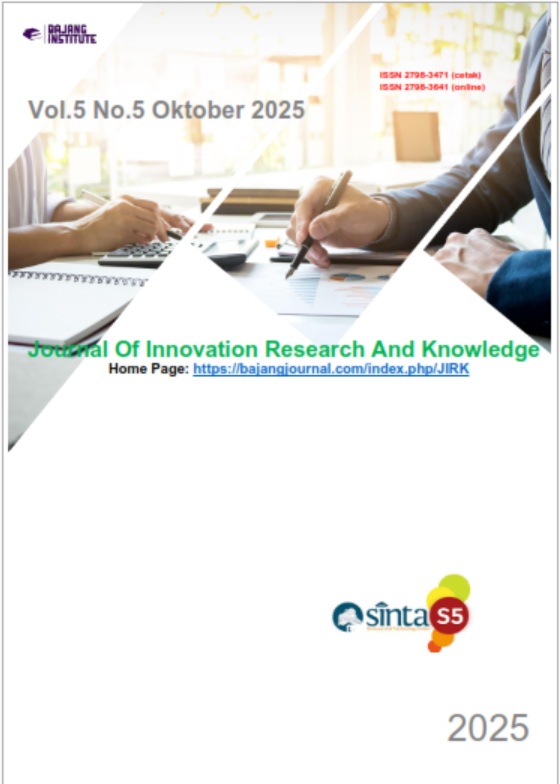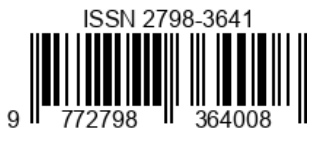JOB CRAFTING SEBAGAI PREDIKTOR WORK ENGAGEMENT PADA KARYAWAN DI PERUSAHAAN PT. SAMINDO UTAMA KALTIM
DOI:
https://doi.org/10.53625/jirk.v5i5.11484Keywords:
Company Employee, Job Crafting;, Work EngagementAbstract
This research was motivated by the importance of work engagement as a factor that influences employee performance and productivity. One factor considered to play a role in enhancing work engagement is job crafting, namely employees’ proactive efforts to adjust their tasks, relationships, and perspectives toward work. The aim of this study was to examine whether job crafting can serve as a predictor of work engagement among employees at PT. Samindo Utama Kaltim. This research employed a quantitative method with a correlational design. The participants consisted of 150 permanent employees who had worked for at least one year, selected using purposive sampling. The research instruments were the job crafting scale and the work engagement scale, both completed online by the participants. Data were analyzed using Pearson correlation and simple linear regression. The results indicated that job crafting is a positive and significant predictor of work engagement, with a contribution of 12%. These findings suggest that employees who engage more actively in job crafting tend to experience higher levels of work engagement. The implication of this study highlights the importance for companies to encourage employees to engage in job crafting by providing work flexibility, opportunities for self-development, and organizational support in order to further enhance work engagement
References
Azwar, S. (2012). Reliabilitas dan Validitas (Edisi ke-4). Pustaka Pelajar.
Bakker, A. B., & Demerouti, E. (2008). Towards A Model of Work Engagement. Career Development International. https://doi.org/10.1108/13620430810870476
Bakker, A. B., & Demerouti, E. (2014). Job Demands–Resources Theory. https://doi.org/https://doi.org/10.1002/9781118539415.wbwell019
Bakker, A. B., Demerouti, E., Boer, E. de, & Schaufeli, W. B. (2003). Job demands and job resources as predictors of absence duration and frequency. Journal of Vocational Behavior, 62(2), 341–356. https://doi.org/https://doi.org/10.1016/S0001-8791(02)00030-1
Bakker, A. B., & Leiter, M. P. (2010). Work Engagement: A Handbook of Essential Theory and Research. New York, NY: Psychology Press. https://doi.org/https://doi.org/10.4324/9780203853047
Bakker, A. B., Tims, M., & Derk, D. (2012). Proactive personality and job performance: The role of job crafting and work engagement. https://doi.org/https://doi.org/10.1177/0018726712453471
Berg, J. M., Dutton, J. E., & Wrzesniewski, A. (2013). Job crafting and meaningful work. In Purpose and meaning in the workplace. https://doi.org/https://doi.org/10.1037/14183-005
Berg, J. M., Wrzesniewski, A., & Dutton, A. E. (2010). Perceiving and responding to challenges in job crafting at different ranks: When proactivity requires adaptivity. Journal of Organizational Behavior, 31(2–3), 158–186. https://doi.org/https://doi.org/10.1002/job.645
Creswell, J. W. (2010). Research design: pendekatan kualitatif, kuantitatif, dan mixed (ed. 4th). Yogyakarta: Pustaka Pelajar.
Creswell, J. W. (2014). Research design: Qualitative, quantitative, and mixed methods approaches (Edisi ke-4). SAGE Publications.
Ghozali, I. (2021). Aplikasi Analisis Multivariate dengan Program IBM SPSS (Edisi ke-1). Badan Penerbit Universitas Diponegoro.
Gujarati, D. N. (2020). Basic Econometrics (ed. 4th).
Harter, J. K., Schmidt, F. L., & Hayes, T. L. (2022). Business-Unit-Level Relationship between Employee Satisfaction, Employee Engagement, and Business Outcomes: A meta-analysis. Journal of Applied Psychology, 87(2), 268–279. https://doi.org/10.1037/0021-9010.87.2.268
Huda Masood, Stefan Karajovic, dan M.-H. B. (2020). Extending the Job Crafting Theory: A Mixed Methods Investigation. Academy of Management Proceedings, Vancouver. https://doi.org/10.5465/AMBPP.2020.10
I. Buil, E. Martínez, dan J. M. (2019). Transformational leadership and employee performance: The role of identification, engagement, and proactive personality. International Journal of Hospitality Management. https://doi.org/10.1016/j.ijhm.2018.06.014
Ike E. Onyishi, Christoph Nohe, Fabian O. Ugwu, Lawrence O. Amazue, dan G. H. (2024). When high work engagement is negative for family tasks: mechanisms and boundary conditions. Frontiers in Psychology, 15. https://doi.org/10.3389/fpsyg.2024.1403701
Joko Wiyanto, Dewi Juliah Ratnaningsih, dan S. S. (2017). Self-efficacy, career development, and work engagement on employee performance: Evidence from aviation sector organisations. Journal of Enterprise and Development (JED), Diterbitkan Oleh Universitas Islam Negeri Mataram. https://doi.org/10.20414/jed.v6i1.9395
Kahn, W. A. (1990). Psychological conditions of personal engagement and disengagement at work. Academy of Management Journal, 33(4), 692–724. https://doi.org/https://doi.org/10.2307/256287
Muhammad Yasir Imran, Natasha Saman Elahi, Ghulam Abid, Fouzia Ashfaq, dan S. I. (2020). Impact of Perceived Organizational Support on Work Engagement: Mediating Mechanism of Thriving and Flourishing. Journal of Open Innovation: Technology, Market, and Complexity, 6(3). https://doi.org/10.3390/joitmc6030082
Najla, lvira A., & Prakoso, H. (2022). Pengaruh Job Crafting terhadap Work Engagement pada Karyawan Bagian Sales Bank X. Jurnal Riset Psikologi, 2(1), 53–60. https://doi.org/https://doi.org/10.29313/jrp.v2i1.833
Parker, S. K., & Collins, C. G. (2018). Taking Stock: Integrating and Differentiating Multiple Proactive Behaviors. Journal of Management, 36(3), 633–662. https://doi.org/https://doi.org/10.1177/0149206308321554
Petrou, P., Bakker, A. B., & Heuvel, M. van den. (2017). Weekly job crafting and leisure crafting: Implications for meaning-making and work engagement. Journal of Occupational and Organizational Psychology, 90(2), 129–152. https://doi.org/https://doi.org/10.1111/joop.12160
Resources, S. (2025). PT. Samindo Utama Kaltim. https://www.samindoresources.com/
Roscoe, J. T. (1975). Fundamental Research Statistics for the Behavioral Sciences. Holt, Rinehart and Winston.
Saks, A. M. (2006). Antecedents and consequences of employee engagement. Journal of Managerial Psychology, 21(7), 600–619. https://doi.org/https://doi.org/10.1108/02683940610690169
Schaufeli, G. M. dan W. B. (2022). The impact of engaging leadership on employee engagement and team effectiveness: A longitudinal, multi-level study on the mediating role of personal- and team resources. PLOS ONE, 17(6). https://doi.org/10.1371/journal.pone.0269433
Schaufeli, W. B., Bakker, A. B., & Salanova, M. (2006). The Measurement of Work Engagement With a Short Questionnaire: A Cross-National Study. Sage Journals, 66(4), 701–716. https://doi.org/https://doi.org/10.1177/0013164405282471
Schaufeli, W. B., & Salanova, M. (2007). Work engagement: An emerging psychological concept and its implications for organizations. In Research in Social Issues in Management (Vol. 5): Managing Social and Ethical Issues in Organizations (pp. 135–177).
Schaufeli, W. B., Salanova, M., González-romá, V., & Bakker, A. B. (2002). The Measurement of Engagement and Burnout: A Two Sample Confirmatory Factor Analytic Approach. Journal of Happiness Studies, 3(71–92). https://doi.org/https://doi.org/10.1023/A:1015630930326
Schaufeli, W., & Bakker, A. (2001). Werk en welbevinden: Naar een positieve benadering in de Arbeids- en Gezondheidspsychologie. Gedrag En Organisatie, 14(5), 229–253. https://pure.eur.nl/en/publications/werk-en-welbevinden-naar-een-positieve-benadering-in-de-arbeids-e
Schaufeli WB, Salanova M, G.-R. V. and B. A. (2001). Relaxation of classical particles in two-dimensional anharmonic single-well potentials. Physical Review E - Statistical Physics, Plasmas, Fluids, and Related Interdisciplinary Topics, 63(2), 5. https://doi.org/10.1103/PhysRevE.63.021114
Sekaran, U. (2023). Research methods for business: A skill building approach (ed. 4th). John Wiley & Sons.
Shutao Zhang, Pengfei Su, S. L. (2021). Fusion of Cognitive Information: Evaluation and Evolution Method of Product Image Form. Computational Intelligence and Neuroscience, Article ID 5524093, 13 pages. https://doi.org/10.1155/2021/5524093
Sugiyono. (2021). Metode Penelitian Kuantitatif, Kualitatif, dan R&D (Edisi ke-2). Alfabeta.
Tims, M., Bakker, A. B., & Derks, D. (2012). Development and validation of the job crafting scale. Journal of Vocational Behavior, 80(1), 173–186. https://doi.org/https://doi.org/10.1016/j.jvb.2011.05.009
Tims, M., Bakker, A. B., & Derks, D. (2013). The impact of job crafting on job demands, job resources, and well-being. Journal of Occupational Health Psychology, 18(2), 230–240. https://doi.org/https://doi.org/10.1037/a0032141
Wrzesniewski, A., & Dutton, J. E. (2001). Crafting a Job: Revisioning Employees as Active Crafters of Their Work. Academy of Management Review, 26(2), 179–201. https://doi.org/https://doi.org/10.5465/amr.2001.4378011
Xanthopoulou, D., Bakker, A. B., Demerouti, E., & Schaufeli, W. B. (2017). The role of personal resources in the job demands-resources model. International Journal of Stress Management, 14(2), 121–141. https://doi.org/https://doi.org/10.103a7/1072-5245.14.2.121
Yesiltas, M. Y. A. dan M. (2024). The Impact of Job Crafting Dimensions on Work Engagement Among Nurses: The mediating role of psychological capital. Asia Pacific Journal of Health Management, 19(2). https://doi.org/10.24083/apjhm.v19i2.3313













